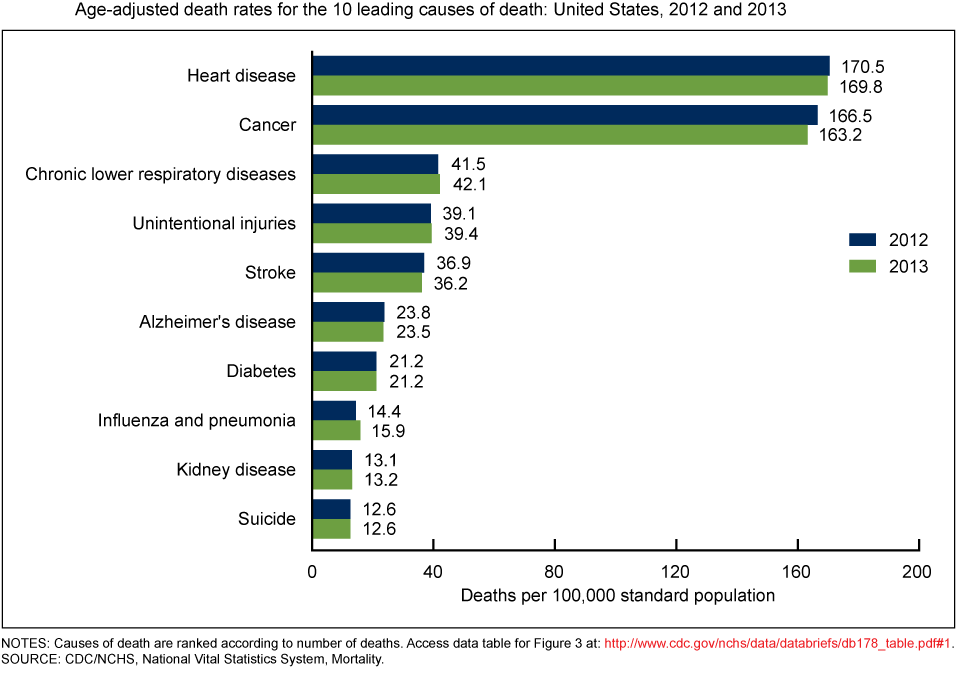March 6, 2020 by John Fernandez
Stroke Drops a Notch to No. 5 ‘Leading Cause of Death’

Stroke has dropped from No. 4 to the No. 5 leading cause of death in the United States, according to a recent update from the U.S. Centers for Disease Control and Prevention.
While still too many people are dying from stroke, there has been much progress in overall treatment and a greater awareness among health care professionals, survivors, researchers and the public as to the vital importance of early intervention.
The CDC reports that stroke swapped positions with unintentional injuries, which killed 1,579 more people than stroke in 2013, according to the very latest data available. In 2013, the 10 leading causes of death were: heart disease, cancer, chronic lower respiratory diseases, unintentional injuries, stroke, Alzheimer’s disease, diabetes, influenza and pneumonia, kidney disease, and suicide.
The stroke death rate slid slightly, from 36.9 percent in 2012 to 36.2 percent in 2013. The death rate from heart disease also dropped only slightly between 2012 and 2013, but it remains the No. 1 cause of death in the nation. (Click on chart to enlarge.)
Still, More People are Having Strokes
The decline in stroke deaths is due in part to improvements in treatment and early intervention. However, more people are having strokes in the U.S. partly because of the aging of the population and signs that strokes have increased in younger groups. Despite the lower death rate, 432 more people died from stroke in 2013 than in 2012, the CDC report found.
Ischemic stroke occurs as a result of an obstruction within a blood vessel supplying blood to the brain. It accounts for 87 percent of all stroke cases and can potentially be treated with tPA, the clot-busting drug. Far fewer strokes are hemorrhagic, caused when a weakened blood vessel ruptures.
“It’s crucial for everyone to understand the importance of treating stroke victims as soon as possible,” said Paul Damski, M.D., a neurologist and Stroke Program Medical Director for Baptist Hospital and West Kendall Baptist Hospital. “The longer you wait after stroke symptoms start, the greater the likelihood of irreversible damage as the brain’s affected region lacks sufficient blood supply.”
Baptist Health’s ‘Telestroke’
Last year, Baptist Health South Florida launched an innovative telemedicine program called Telestroke, the type of early-intervention effort that is helping save the lives of stroke victims across the nation.
The most effective treatments for stroke must be given within three hours after the onset of symptoms. Therefore, it is vital to recognize the signs of a stroke so that you or someone with you can act quickly and call 9-1-1.
Through Telestroke, patients with stroke symptoms at West Kendall Baptist Hospital, which already provides primary stroke care, have immediate 24-hour access to neurologists at Baptist Health Neuroscience Center to enhance response time when needed.
“When I’m alerted by West Kendall, I’m on my iPad within seconds on a video conference,” Dr. Damski says. “I can talk and see the patient at the other end and I can talk with their family members as well. I can also guide the clinical staff on the best treatment, which may include tPA or other options.”
A 60-Minute Window for Treatment
The American Stroke Association recommends that a patient get treated within 60 minutes of walking into the hospital ER.
“The fact that the death rate is declining from this terrible and devastating disease is gratifying news,” said American Heart Association President Elliott Antman, M.D. “These statistics are a tribute to the many courageous survivors, healthcare professionals, researchers, volunteers and everyone else committed to fighting stroke.”
The most widely recognized symptoms of a stroke include:
• Numbness or weakness in the face, arms or legs, particularly on one side of the body.
• Sudden disorientation, confusion or trouble speaking.
• Trouble seeing in one or both eyes.
• Difficulty in walking, lack of coordination, dizziness or a loss of balance.
• Severe, sudden headache without a known cause.
top stories













There are no comments